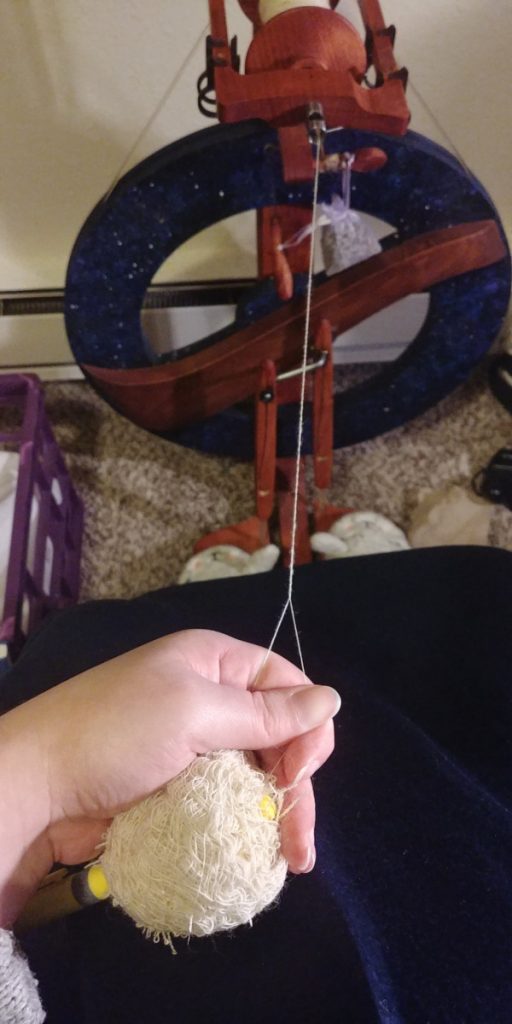Week two had a little bit everything in it, though it was still mostly spinning. I started by updating this website – besides the obvious change in color scheme, I added photos to the image gallery, added categories and reorganized my posts to easier differentiate between fall quarter and winter quarter. I also played around with the Map widget, though I’m not sure I did it correctly? I mean, I know I added locations that can be seen on the “Map” page, but I think it would be nice to see individual maps on posts that I mark locations. But, I seem to only be able to mark one location for single posts, which isn’t what I want, and I don’t have the energy to figure out how to make it work at the moment.
I also had to do some thinking about my wool situation. In my sleep-deprived state last quarter, it did not occur to me that while the loom I’ll be using may be 36 inches wide, that is not how wide the weaving area is. It finally occurred to me to check and the widest textile I can weave is 28 inches, which isn’t nearly wide enough. I’ve decided to weave four panels of fabric, sewing two together to make the front and the two to make the back. To minimize yarn waste I’ll weave two panels on one warp, but I still had to recalculate how much yarn I have to spin. Luckily, it isn’t too much of an increase: I now need about 4,200 yards instead of 3,800 yards. It’s about an extra skein of yarn.
That is still a lot of yarn though, and I had planned on buying different roving. It took me a bit of time to find something that would still work for what I wanted – a wool that wasn’t too coarse and would be okay to lay next to the skin, white so I could dye it, and ready more or less for me to spin – while still trying to be as ethical and sustainable as possible. I decided to look for a conservation sheep breed. I remembered that there’s something called the Shave ‘Em To Save ‘Em program by the Livestock Conservancy that connects fiber artists with farms and shepherds that raise endangered breeds of sheep; many times the fleece of these sheep will just be composted, but there are many people (like me) who are willing to pay money for the wool and support the people who care for these animals. In this way we can hopefully save the sheep breeds from extinction.
I looked through the Fleece and Fiber Sourcebook for what sheep breed I might want to look for and I decided on Teeswater. One of the things I love about my current wool is how lustrous it is, which is because one of the sheep’s parents is a Blue Face Leicester (BFL for short). BFL are known for lustrous springy locks, but they aren’t endangered. Other breeds that are related to BFL are endangered, but their wool tends to have a higher micron count. This doesn’t always translate to coarseness, but I’ve never worked with any of their wool, so I don’t actually know what they feel like. Teeswater also has a higher micron count that normally wouldn’t be considered next-to-skin soft, but I’ve worked with Teeswater before and it tends to have a silkiness to it regardless. It’s also terribly lustrous.
Between looking though the Livestock Conservancy’s directory and inputting, “SE2SE” into the Etsy search engine, I found a farm near Portland, OR, called Lawrence Cottage (link to Etsy store here). The owner, Staci, raises both Teeswater and Gotland sheep and did a lot of work with the American Teeswater Sheep Association to get the sheep breed listed as critically endangered with the Livestock Conservancy. Lawrence Cottage also has an Instagram, where pictures of Staci’s adorable and obviously happy sheep can be found. Teeswater are a longwool breed (they have been in Britain since the first century CE when Romans brought an ancestor sheep over) and their long lustrous curls are hard to miss.
Photography credits to Lawrence Cottage
Finally, I started plying another bobbin of yarn. I’ve learned that my ball winder, which I use to make a center-pull ball with which I ply, can only hold about 3-4 ounces of fiber and with how fine I’m spinning, that ends up being about half of one of my bobbins. So when I say I’m plying a bobbin of yarn, I mean half a bobbin. Plying seems like it should be easier, but for whatever reason, it isn’t for me. I have to concentrate more about what I’m doing, I suppose. I have to hold both ends of the yarn with equal tension, otherwise the yarn will come out uneven. I believe there are times when you would ply unevenly on purpose if you’re making an art yarn…but I’ve never been interested in making that kind of yarn. I’m the type who wants to see how finely I can spin and how perfect can I make my yarn. I’m not a perfectionist…not at all!


